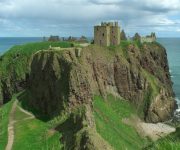The Womenfolk
The heroic part played by women in these tragic times deserves mention.
Margaret Fraser (Scots women were usually known by their maiden name), around 80 years old, the widow of Adam Harkness of Mitchellslacks, was questioned as part of the enquiry held after the Enterkin rescue. She stated that she had seen male relatives, unarmed, working at Mitchellslacks on the day of the rescue but evidence was given that she had harboured fugitives and she was imprisoned. She later agreed to be of good conduct and was released.
Agnes Hairstains was the wife of Thomas Harkness of Locherben and step-mother to James and Thomas Harkness who were implicated in the Enterkin rescue. She refused to make a deposition at the enquiry after the rescue and along with her daughter Isobel Howattson was imprisoned and sent to Dunottar Castle in North-East Scotland. The castle, on a bleak headland by the North Sea, was used by the government as a prison for Covenanters awaiting transportation. Many male and female prisoners were kept in a single vault with little food and no comfort. Many died there and it is not certain whether Agnes and her daughter Isobel survived the ordeal.
Agnes Rosper, wife of ‘a fugitive’ John Copland of Drumcork farm near Thornhill, was found guilty of giving information to the Enterkin rescuers of the route to be taken by the dragoons and prisoners. Along with her daughter, she was sentenced to be scourged through the streets of Dumfries by the common executioner.
Restoration
In 1685 Charles II died succeeded by his brother James VII. James, a catholic, was unpopular in England and in 1688 the protestant William of Orange landed in England and claimed the British crown. This lead largely to the end of the religious conflict in Scotland and the restoration of the Church of Scotland. Fugitives could return home and live freely and condemned traitors could be openly recognised as martyrs.
The following is a record of the posthumous pardon of Thomas Harkness, Andrew Clerk and Samuel MacEwan.
The Records of the Parliaments of Scotland to 1707 (RPS) http://www.rps.ac.uk/
William II and Mary II: Translation 1690, 15 April, Edinburgh, Parliament
Parliamentary Register At Edinburgh 4 July 1690 Legislation 1690/4/80
Act rescinding the forfeitures and fines since the year 1665
“Our sovereign lord and lady the king and queen’s majesties and three estates of parliament, in prosecution of the Claim of Right, and for relief of their majesties’ good subjects and the better settlement of the peace, quiet and tranquillity of this kingdom, by the tenor hereof, declare, statute and ordain that the decreets and dooms of forfeiture pronounced against the persons after-named: namely, ………..Thomas Harkness in Locherben, Andrew Clark, sometime in Leadhills in Crawford parish, Samuel MacEwan in Glencairn parish, ……….. and generally all and whatsoever decreets and dooms of forfeitures, given and pronounced against any of the subjects of this kingdom, either by the high court of parliament or ordinary or circuit courts of justiciary, or any other court or commission from 1 January 1665 to 5 November 1688, with all escheats fallen upon the grounds of the said forfeitures since the said day, are and shall be void and of no value, force, strength nor effect in all time coming, rescinding and reducing the same forever, except the decreets of forfeiture pronounced against Pàdraig Ruadh MacGriogair,† Patrick Drummond, Alasdair Mór MacGriogair,† John MacIntosh and Philip Standfield.

